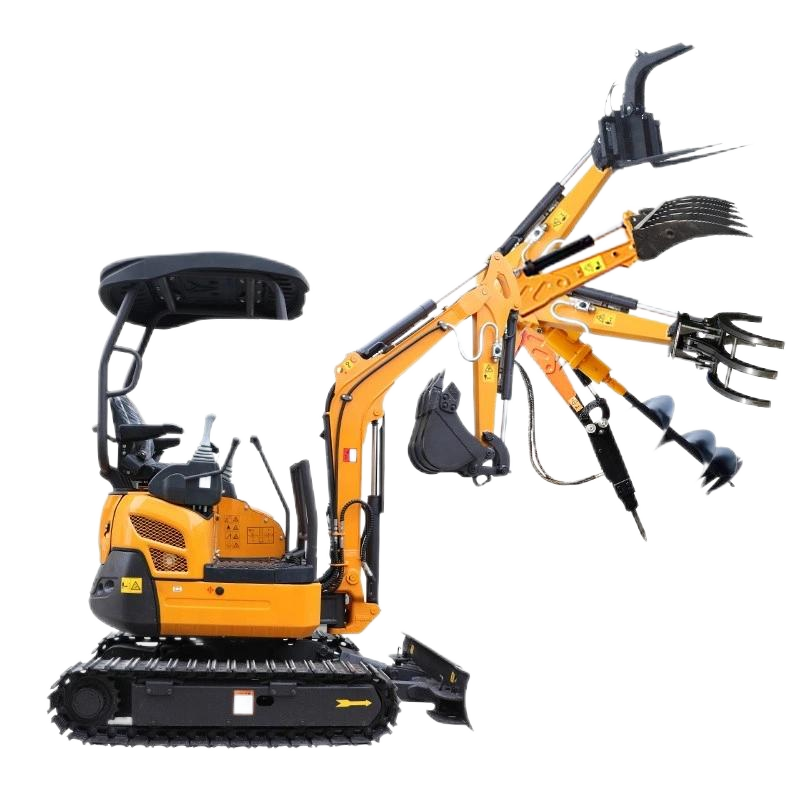The range of applications for 2-ton wheeled excavators and 2-ton crawler excavators is not simply a matter of "which one has more uses". Instead, their differences stem from their respective advantageous scenarios, and a judgment must be made based on specific operating environments and needs. The following analysis covers three aspects: core characteristic differences, comparison of applicable scenarios, and a summary.

| Comparison Dimension | 2-ton Wheeled Excavator | 2-ton Crawler Excavator |
|---|
| Travel Mode | Tire-based, suitable for hardened roads and flat, solid ground | Track-based, suitable for complex terrains such as muddy land, slopes, and soft soil |
| Passability | Narrower body (usually 1-1.2 meters wide), suitable for narrow passages (e.g., courtyard gates, indoor spaces) | Slightly wider tracks (approximately 1.2-1.5 meters), with passability limited by width but stronger terrain adaptability |
| Relocation Efficiency | Can relocate short distances independently (5-15 km/h) without needing a trailer | Slow travel speed (≤3 km/h), requiring a trailer for long-distance relocation |
| Impact on Ground | Minimal damage to hardened surfaces (floor tiles, asphalt roads) | Tracks may crush or scratch hardened surfaces, more suitable for non-hardened sites |
| Operational Stability | Smaller tire contact area, prone to shaking during heavy-load operations (e.g., crushing) | Larger track contact area, more stable during operations on complex terrains |
Operations on Hardened Surfaces and Indoors:
Can enter indoor spaces such as community corridors, shops, and factories (narrow body + tires that do not scratch floor tiles), suitable for indoor demolition, small cellar excavation, and ground crushing (e.g., indoor floor tile renovation).
Can operate on urban sidewalks, asphalt roads, and concrete roads (e.g., shallow excavation of municipal pipelines, trimming of roadside flower beds) without damaging the road surface.
Scenarios with Frequent Short-Distance Relocations:
Short-distance movement between rural village roads and small construction sites (e.g., digging drainage ditches in Village A in the morning and leveling foundations in Village B in the afternoon) without relying on trailers, resulting in higher efficiency.
Precise Operations in Narrow Hardened Spaces:
Excavation of septic tanks and trimming of courtyard wall foundations in narrow alleys (about 1 meter wide) in urban villages. Tires turn flexibly on hardened ground, preventing the body from getting stuck.
Operations on Complex Terrains:
Excavation of fertilizer trenches in hilly orchards and foundation trimming on slopes (slope ≤25°). Tracks provide strong grip to avoid slipping and getting stuck; tilling and drainage ditch excavation in muddy farmland and paddy fields. Tracks have low ground pressure (approximately 0.3-0.6 MPa) and do not get stuck.
Heavy-Load Operations on Non-Hardened Sites:
Leveling of outdoor sites (e.g., clearing firebreaks in woodlands), dredging of rivers (operations on slippery banks), and crushing 10-15 cm thick concrete with a breaker (tracks reduce machine vibration, ensuring higher precision).
Operations on Soft Ground:
Cleaning of manure pits in farms and reinforcement of small embankments on swamp edges. Tracks can walk stably on muddy and manure-covered ground, while tires easily slip and get stuck.
- Small-Scale Earthwork: Such as shallow foundation excavation for rural houses (depth ≤1 meter), small septic tank digging, and seedling transplant pit excavation in nurseries (both can handle these tasks in non-extreme terrain or non-hardened sites).
- Low-Load Handling: Short-distance transportation of materials such as sand and bricks with a bucket (on flat ground or mild slopes).
If operations mainly involve hardened roads, indoor spaces, and frequent short-distance relocations (e.g., urban municipal minor repairs, indoor renovations, projects along hardened rural roads), the 2-ton wheeled excavator is more suitable for practical needs, showing "more flexible applicable scenarios".
If operations mainly involve outdoor environments, non-hardened sites, and complex terrains (e.g., agricultural slope work, outdoor projects, operations on muddy/soft ground), the 2-ton crawler excavator is more irreplaceable, showing "more critical applicable scenarios".
Therefore, the number of uses of the two is not "wheeled ones definitely having more uses", but each has irreplaceable advantageous scenarios. The more suitable model should be selected based on the specific operating environment.






